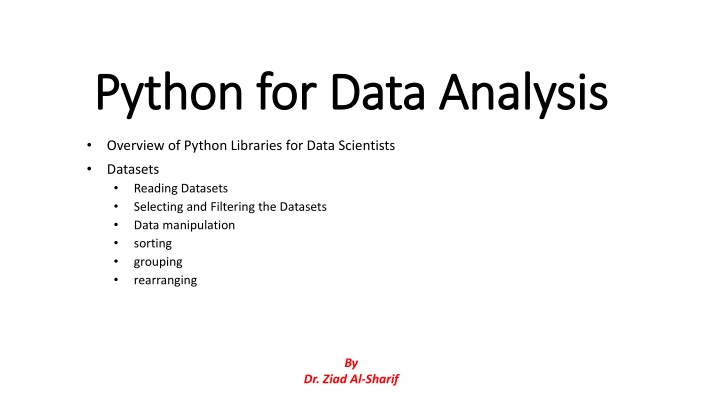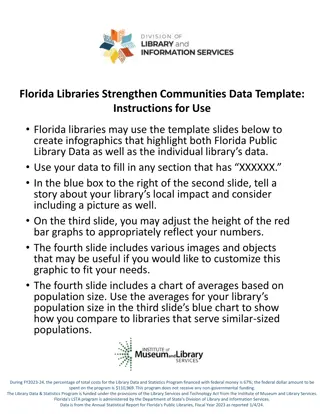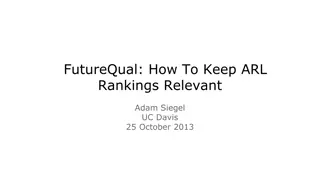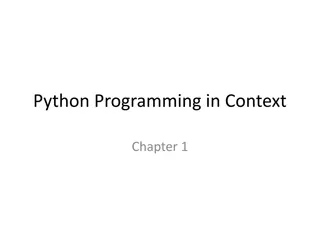Overview of Python Libraries for Data Scientists
This overview covers essential Python libraries for data scientists, including NumPy, SciPy, Pandas, and matplotlib. NumPy introduces objects for multidimensional arrays and matrices, SciPy offers a collection of algorithms for various mathematical operations, Pandas provides tools for data manipulation, and matplotlib is a 2D plotting library for creating high-quality visualizations. These libraries are fundamental for data analysis, manipulation, and visualization tasks in Python.
Download Presentation

Please find below an Image/Link to download the presentation.
The content on the website is provided AS IS for your information and personal use only. It may not be sold, licensed, or shared on other websites without obtaining consent from the author.If you encounter any issues during the download, it is possible that the publisher has removed the file from their server.
You are allowed to download the files provided on this website for personal or commercial use, subject to the condition that they are used lawfully. All files are the property of their respective owners.
The content on the website is provided AS IS for your information and personal use only. It may not be sold, licensed, or shared on other websites without obtaining consent from the author.
E N D
Presentation Transcript
Python for Data Analysis Python for Data Analysis Overview of Python Libraries for Data Scientists Datasets Reading Datasets Selecting and Filtering the Datasets Data manipulation sorting grouping rearranging By Dr. Ziad Al-Sharif
Python Libraries for Data Science Python Libraries for Data Science Many popular Python toolboxes/libraries: NumPy SciPy Pandas SciKit-Learn Visualization libraries matplotlib Seaborn and many more 2
Python Libraries for Data Science Python Libraries for Data Science NumPy: introduces objects for multidimensional arrays and matrices, as well as functions that allow to easily perform advanced mathematical and statistical operations on those objects provides vectorization of mathematical operations on arrays and matrices which significantly improves the performance many other python libraries are built on NumPy Link: http://www.numpy.org/ 3
Python Libraries for Data Science Python Libraries for Data Science SciPy: pronounced Sigh Pie collection of algorithms for linear algebra, differential equations, numerical integration, optimization, statistics and more part of SciPy Stack built on NumPy Link: https://www.scipy.org/scipylib/ 4
Python Libraries for Data Science Python Libraries for Data Science Pandas: adds data structures and tools designed to work with table-like data (similar to Series and Data Frames in R); good for datasets provides tools for data manipulation: reshaping, merging, sorting, slicing, aggregation, etc. allows handling missing data Link: http://pandas.pydata.org/ 5
Python Libraries for Data Science Python Libraries for Data Science matplotlib: python 2D plotting library which produces publication quality figures in a variety of hardcopy formats a set of functionalities similar to those of MATLAB line plots, scatter plots, barcharts, histograms, pie charts, etc. relatively low-level; some effort needed to create advanced visualization Link: https://matplotlib.org/ 6
Python Libraries for Data Science Python Libraries for Data Science Seaborn: based on matplotlib provides high level interface for drawing attractive statistical graphics Similar (in style) to the popular ggplot2 library in R Link: https://seaborn.pydata.org/ 7
Python Libraries for Data Science Python Libraries for Data Science SciKit-Learn: provides Machine Learning (ML) algorithms: classification, regression, clustering, model validation, etc. built on NumPy, SciPy and matplotlib Link: http://scikit-learn.org/ 8
Python Libraries for Data Science Python Libraries for Data Science statsmodels: provides classes and functions for the estimation of many different statistical models, as well as for conducting statistical tests, and statistical data exploration. Link: https://www.statsmodels.org 9
Summary Summary 10
Reading and Loading Datasets Reading and Loading Datasets ACase Study https://www.just.edu.jo/~zasharif/Web/SE412/Examples/ML/CaseStudy/Salaries.csv https://www.just.edu.jo/~zasharif/Web/SE412/Examples/ML/CaseStudy/flights.csv https://archive.ics.uci.edu/ml/machine-learning-databases/autos/ https://archive.ics.uci.edu/ml/machine-learning-databases/autos/imports-85.data 11
Start Start Jupyter Jupyter nootebook nootebook Anaconda Users: Click here From your shell or cmd terminal: Type this command $jupyter notebook 12
Loading Python Libraries Loading Python Libraries #Import Python Libraries import numpy as np import scipy as sp import pandas as pd import matplotlib as plt import seaborn as sns In [ ]: Press Shift+Enter to execute the jupyter cell 13
Reading data using pandas from a public website Reading data using pandas from a public website In [ ]: #Read csv file url = "https://www.just.edu.jo/~zasharif/Web/SE412/Examples/ML/CaseStudy/Salaries.csv" df = pd.read_csv(url) Note: The above command has many optional arguments to fine-tune the data import process. There is a number of pandas commands to read other data formats: pd.read_excel('myfile.xlsx',sheet_name='Sheet1', index_col=None, na_values=['NA']) pd.read_stata('myfile.dta') pd.read_sas('myfile.sas7bdat') pd.read_hdf('myfile.h5','df') 14
Using Using Colab Colab from Google from Google Colaboratory, or Colab for short, are Jupyter Notebooks hosted by Google that allow you to write and execute Python code through your browser. it is an internal tool for data analysis at Google. Colab is easy to use and link it to your Google account. provides free access to GPUs and TPUs, (on the cloud) requires zero configuration, easy to share your code with the community. Many people have been using this tool to achieve their machine learning tasks. Most users utilize colab for the free resources to run their Data Science experiments. 15
Uploading files from your local file Uploading files from your local file system in system in Colab Colab files.upload returns a dictionary of the files which were uploaded. The dictionary is keyed by the file name and values are the data which were uploaded. from google.colab import files uploaded = files.upload() for fn in uploaded.keys(): print('User uploaded file "{name}" with length {length} bytes'.format( name=fn, length=len(uploaded[fn]))) 16
Downloading Downloading files from files from Colab Colab to your local file system to your local file system files.download will invoke a browser download of the file to your local computer. from google.colab import files with open('example.txt', 'w') as f: f.write('some content') files.download('example.txt') More Information can be found about External data: Local Files, Drive, Sheets, and Cloud Storage at: https://colab.research.google.com/notebooks/io.ipynb#scrollTo=p2E4EKhCWEC5 17
Reading data using pandas in Reading data using pandas in google s google s colab colab In [ ]: # To upload from your local drive, start with the following code from google.colab import files uploaded = files.upload() # It will prompt you to select a file. Click on Choose Files then select # and upload the file. Wait for the file to be 100% uploaded. # You should see the name of the file once Colab has uploaded it. # # Finally, type in the following code to import it into a dataframe # (make sure the filename matches the name of the uploaded file). # For Example: to read the uploaded file: Salaries.csv import io df = pd.read_csv(io.BytesIO(uploaded['Salaries.csv'])) # Dataset is now stored in a Pandas Dataframe df.head(2) Resource: https://towardsdatascience.com/3-ways-to-load-csv-files-into-colab-7c14fcbdcb92 18
Reading data using pandas in Reading data using pandas in google s google s colab colab 19
Introduction to pandas and its Data Frame part #1 part #1 By Dr. Ziad Al-Sharif 20
Exploring data frames Exploring data frames In [3]: #List first 5 records df.head() Out[3]: 21
Hands Hands- -on exercises on exercises Try to read the first 10, 20, 50 records; Can you guess how to view the last few records; Hint: 22
Data Frame data types Data Frame data types Pandas Type Native Python Type Description object string The most general dtype. Will be assigned to your column if column has mixed types (numbers and strings). int64 int Numeric characters. 64 refers to the memory allocated to hold this character. float64 float Numeric characters with decimals. If a column contains numbers and NaNs(see below), pandas will default to float64, in case your missing value has a decimal. datetime64, timedelta[ns] N/A (but see the datetime module in Python s standard library) Values meant to hold time data. Look into these for time series experiments. 23
Data Frame data types Data Frame data types In [4]: #Check a particular column type df['salary'].dtype Out[4]: dtype('int64') In [5]: #Check types for all the columns df.dtypes Out[4]: 24
Data Data Frames Frames attributes attributes Pandas Python objects have attributes and methods. df.attribute dtypes columns axes description list the types of the columns list the column names list the row labels and column names ndim number of dimensions size number of elements shape return a tuple representing the dimensionality values numpy representation of the data 25
Hands Hands- -on exercises on exercises Find how many records this data frame has; How many elements are there? What are the column names? What types of columns we have in this data frame? 26
Data Data Frames Frames methods methods Unlike attributes, python methods have parenthesis. All attributes and methods can be listed with a dir() function: dir(df) df.method() description head( [n] ), tail( [n] ) first/last n rows describe() generate descriptive statistics (for numeric columns only) max(), min() return max/min values for all numeric columns mean(), median() return mean/median values for all numeric columns std() standard deviation sample([n]) returns a random sample of the data frame dropna() drop all the records with missing values 27
Hands-on exercises Give the summary for the numeric columns in the dataset Calculate standard deviation for all numeric columns; What are the mean values of the first 50 records in the dataset? Hint: use head() method to subset the first 50 records and then calculate the mean 28
Selecting Selecting a column in a Data Frame a column in a Data Frame How do I select a subset of a DataFrame? Method 1: Subset the data frame using column name: df['salary'] Method 2: Use the column name as an attribute: df.salary Note: there is an attribute rank for pandas data frames, so to select a column with a name "rank" we should use method 1. 29
Hands-on exercises Calculate the basic statistics for the salary column; Find how many values in the salary column (use count method); Calculate the average salary; 30
Data Frames Data Frames groupby method method Using "group by" method we can: Split the data into groups based on some criteria (Split a table into groups) Calculate/Apply statistics (or apply a function) to each group (Apply some operations to each of those smaller tables) Combine the results E.g. if we want to find the mean for each group based on the rank of the professors, we may use groupby as follows: In [ ]: #Group data using rank df_rank = df.groupby(['rank']) In [ ]: #Calculate mean value for each numeric column per each group df_rank.mean() Out[ ]: 31
Data Frames Data Frames groupby method method Once groupby object is create we can calculate various statistics for each group: In [ ]: #Calculate mean salary for each professor rank: df.groupby('rank')[['salary']].mean() Out[ ]: Note: If single brackets are used to specify the column (e.g. salary), then the output is Pandas Series object. When double brackets are used the output is a Data Frame 32
Data Frames groupby method groupby performance notes: - no grouping/splitting occurs until it's needed. Creating the groupby object only verifies that you have passed a valid mapping - by default the group keys are sorted during the groupby operation. - You may want to pass sort=False for potential speedup: - In [ ]: #Calculate mean salary for each professor rank: df.groupby(['rank'], sort=False)[['salary']].mean() Out[ ]: 33
Data Frame: Data Frame: filtering filtering How do I filter specific rows from a DataFrame? To subset the data we can apply Boolean indexing. This indexing is commonly known as a filter. E.g. to subset the rows in which the salary value is greater than $120K: In [ ]: #Calculate mean salary for each professor rank: df_sub = df[ df['salary'] > 120000 ] Any Boolean operator can be used to subset the data: > greater; >= greater or equal; < less; <= less or equal; == equal; != not equal; In [ ]: #Select only those rows that contain female professors: df_f = df[ df['sex'] == 'Female' ] 34
Data Frames: Data Frames: Slicing Slicing There are a number of ways to subset the Data Frame: one or more columns one or more rows a subset of rows and columns Rows and columns can be selected by their position or label 35
Data Frames: Data Frames: Slicing Slicing When selecting one column, it is possible to use single set of brackets, but the resulting object will be a Series (not a DataFrame): In [ ]: #Select column salary: df['salary'] When we need to select more than one column and/or make the output to be a DataFrame, we should use double brackets: In [ ]: #Select column salary: df[['rank','salary']] 36
Data Frames: Data Frames: Selecting Selecting rows rows If we need to select a range of rows, we can specify the range using ":" In [ ]: #Select rows by their position: df[10:20] Out[ ]: Notice that the first row has a position 0, and the last value in the range is omitted: So for 0:10 range the first 10 rows are returned with the positions starting with 0 and ending with 9 37
method loc Data Frames: Data Frames: method If we need to select a range of rows, using their labels we can use method loc: In [ ]: #Select rows by their labels: df.loc[10:20,['rank','sex','salary']] Out[ ]: 38
method iloc Data Frames: Data Frames: method If we need to select a range of rows and/or columns, using their positions we can use method iloc: In [ ]: #Select rows by their index: df.iloc[10:20,[0, 3, 4, 5]] Out[ ]: 39
Data Frames: method iloc (summary) df.iloc[0] # First row of a data frame df.iloc[i] #(i+1)th row df.iloc[-1] # Last row df.iloc[:, 0] # First column df.iloc[:, -1] # Last column df.iloc[0:7] #First 7 rows df.iloc[:, 0:2] #First 2 columns df.iloc[1:3, 0:2] #Second through third rows and first 2 columns df.iloc[[0,5], [1,3]] #1st and 6th rows and 2nd and 4th columns 40
Data Frames: Data Frames: Sorting Sorting We can sort the data by a value in the column. By default the sorting will occur in ascending order and a new data frame is return. In [ ]: # Create a new data frame from the original sorted by the column Salary df_sorted = df.sort_values( by ='salary') df_sorted.head() Out[ ]: 41
Data Frames: Data Frames: Sorting Sorting We can sort the data using 2 or more columns: In [ ]:df_sorted = df.sort_values( by=['yrs.since.phd','salary'], ascending = [True, False]) df_sorted.head(10) Out[ ]: 42
Extra Reading Handling Missing Values 43
Missing Values Missing values are marked as NaN In [ ]: # Read a dataset with missing values url = "https://www.just.edu.jo/~zasharif/Web/SE412/Examples/ML/CaseStudy/flights.csv" df_flights = pd.read_csv(url) In [ ]: # Select the rows that have at least one missing value df_flights[flights.isnull().any(axis=1)].head() Out[ ]: 44
Missing Values Missing Values There are a number of methods to deal with missing values in the data frame: df.method description dropna() Drop missing observations dropna(how = 'all') Drop observations where all cells is NA dropna(axis=1, how='all') Drop column if all the values are missing dropna(thresh = 5) Drop rows that contain less than 5 non-missing values fillna(0) Replace missing values with zeros isnull() returns True if the value is missing notnull() Returns True for non-missing values 45
Missing Values When summing the data, missing values will be treated as zero If all values are missing, the sum will be equal to NaN cumsum() and cumprod() methods ignore missing values but preserve them in the resulting arrays Missing values in GroupBy method are excluded Many descriptive statistics methods have skipna option to control if missing data should be excluded . This value is set to True by default 46
Aggregation Functions in Pandas Aggregation - computing a summary statistic about each group, i.e. compute group sums or means compute group sizes/counts Common aggregation functions: min, max count, sum, prod mean, median, mode, mad std, var 47
Aggregation Functions in Pandas agg() method are useful when multiple statistics are computed per column: In [ ]: df_flights[['DepDelay','ArrDelay']].agg(['min','mean','max']) Out[ ]: 48
Basic Descriptive Statistics df.method description describe Basic statistics (count, mean, std, min, quantiles, max) min, max Minimum and maximum values mean, median, mode Arithmetic average, median and mode var, std Variance and standard deviation sem Standard error of mean skew Sample skewness kurt kurtosis 49
Graphics to explore the data Graphics to explore the data Seaborn package is built on matplotlib but provides high level interface for drawing attractive statistical graphics. It specifically targets statistical data visualization You can create plots in pandas too !? To show graphs within Python jupyter notebook, you need to include inline directive: In [ ]: %matplotlib inline 50























